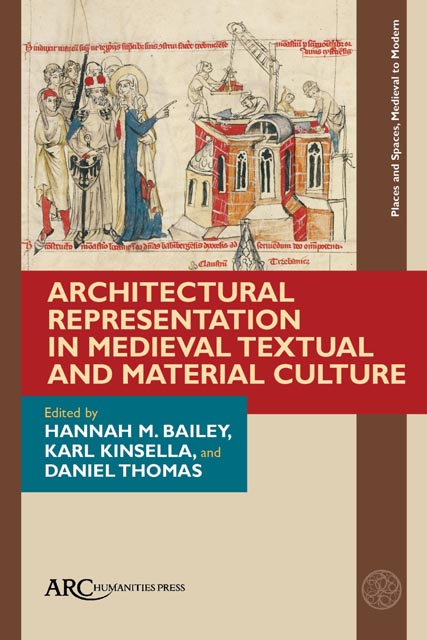Book contents
- Frontmatter
- Contents
- List of Illustrations
- Acknowledgements
- Introduction: Architectural Representation in Medieval Textual and Material Culture
- Chapter 1 Designing the Regensburg Spire and Harburg Tabernacle: The Geometries of Two Great German Gothic Drawings
- Chapter 2 Wilfrid’s Restoration of the Church at York and the Permanence of Sacred Buildings in Post-Conversion Northumbria
- Chapter 3 Heaven-Roofs and Holy Altars: Envisioning a Seventh-Century English Church in Aldhelm’s Carmina Ecclesiastica 3
- Chapter 4 “Beaten Down and Built Anew”: Saint Erkenwald and Old St. Paul’s
- Chapter 5 Castle Viewscapes in Literature and Landscapes
- Chapter 6 Architectural Alignment in Early Medieval English Settlements: Zoning, Meaning, and Function
- Chapter 7 Underneath the Arches: Peter of Eboli and the Orderly Architecture of Norman Sicily
- Chapter 8 Reading the Saint’s Church: A Northern Perspective
- Select Bibliography
- Index
Chapter 5 - Castle Viewscapes in Literature and Landscapes
Published online by Cambridge University Press: 16 November 2023
- Frontmatter
- Contents
- List of Illustrations
- Acknowledgements
- Introduction: Architectural Representation in Medieval Textual and Material Culture
- Chapter 1 Designing the Regensburg Spire and Harburg Tabernacle: The Geometries of Two Great German Gothic Drawings
- Chapter 2 Wilfrid’s Restoration of the Church at York and the Permanence of Sacred Buildings in Post-Conversion Northumbria
- Chapter 3 Heaven-Roofs and Holy Altars: Envisioning a Seventh-Century English Church in Aldhelm’s Carmina Ecclesiastica 3
- Chapter 4 “Beaten Down and Built Anew”: Saint Erkenwald and Old St. Paul’s
- Chapter 5 Castle Viewscapes in Literature and Landscapes
- Chapter 6 Architectural Alignment in Early Medieval English Settlements: Zoning, Meaning, and Function
- Chapter 7 Underneath the Arches: Peter of Eboli and the Orderly Architecture of Norman Sicily
- Chapter 8 Reading the Saint’s Church: A Northern Perspective
- Select Bibliography
- Index
Summary
Introduction
Castles have a long tradition of being studied either as military centres or as symbolic constructions of power. This binary distinction, which Creighton and Liddiard call a “false dichotomy,” does not encompass the range of lived experience of medieval European life, which was multi-faceted and complex, simultaneously incorporating many different elements. This chapter will use a cultural landscape approach to study the medieval built environment and the interdisciplinary collaboration of the disparate fields of archaeology, physics, and literature to develop a more holistic understanding of the medieval castle and the society of which it was a part. This approach looks at castles as an integrated part of the construction of social hierarchy and draws on both modern and medieval perspectives on the medieval cultural landscape. Most studies of this nature focus on one or the other perspective; the interdisciplinary nature of this study puts both into a single arena, creating a more comprehensive view of the medieval architectural and experiential world.
When modern people examine castles, our experiences are shaped by our own sense of perception. Castles are heritage sites, and as such they confer a sense of history and a set of spatial experiences that are distinctly different from those inspired by the modern built environment. These experiences provide a step toward understanding medieval life. Walking through the halls and chambers gives us a fragment of what life in those spaces was like, but it is only a fragment. To gain a deeper understanding, we need to gain access to other aspects of medieval life, and one way to do that is through documentary and literary sources. Every document is written with a purpose and intent, and analysis allows us to understand both the intent and the underlying beliefs integral to the medieval worldview. This brings us a step closer to understanding the medieval lived experience. A further challenge is that castles are not in the same physical condition they were in during the medieval period. Castles still in use have been modified, while castles that went out of use have suffered the decay of time. Physical reconstruction is often impossible for many practical reasons, but digital reconstruction is a viable option because it creates a model that can be compared with castles as they are depicted in historical and literary texts.
- Type
- Chapter
- Information
- Publisher: Amsterdam University PressPrint publication year: 2023

